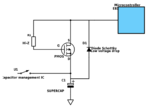benji54
Newbie level 5
Hi everyone,
I am wondering how I can manage with different voltages from different super cap.
I explain the schematic below, I have 4 supercap (400mF rated 3.3v) that are charged by different controlers from generators. This means that at a time T1s the C1 could provide maybe 3.24V if it is fully charged or 1.24v if not, same for C2 and C3 (0 to 3.3v) and C4 between 3.2-1V. My problem is that I want to supply a low power microcontroler using the energy available on fourth capacitors.
If I connect all the capa together it means that the voltage will equalize itself, that why I put a diode after each supercap to get no current reverse from a super cap to another one. Is this schematic can work?

I am wondering how I can manage with different voltages from different super cap.
I explain the schematic below, I have 4 supercap (400mF rated 3.3v) that are charged by different controlers from generators. This means that at a time T1s the C1 could provide maybe 3.24V if it is fully charged or 1.24v if not, same for C2 and C3 (0 to 3.3v) and C4 between 3.2-1V. My problem is that I want to supply a low power microcontroler using the energy available on fourth capacitors.
If I connect all the capa together it means that the voltage will equalize itself, that why I put a diode after each supercap to get no current reverse from a super cap to another one. Is this schematic can work?



